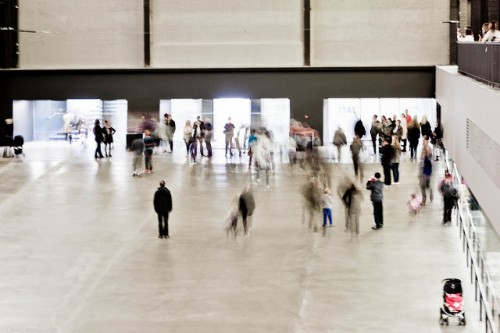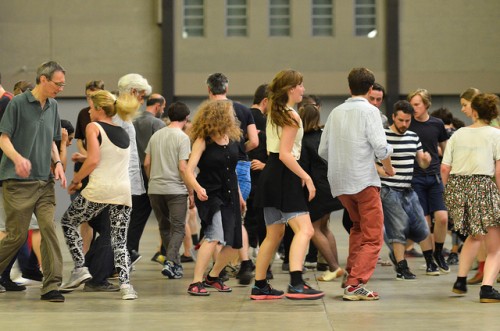UNTIL RECENTLY THE vast turbine hall of London’s Tate Modern gallery was home to a rather disorderly group of performers. They weren’t in costume; they weren’t really performing, and they chatted to their audience. They were art. They made up Tino Sehgal’s “These Associations,” his contribution to the Tate Modern’s Unilever series, and the final commission in a twelve-year run that’s challenged thirteen artists including Anish Kapoor, Louise Bourgeois, Bruce Nauman and Rachel Whiteread, to make an impact in a space the size of an aircraft hanger. For his piece Carsten Höller installed huge slides like a fun-fair, providing quick exits from the higher floors; Olafur Eliasson’s “Weather Project” came complete with mist, huge indoor sun and mirrored ceiling, and if Ai Weiwei’s “Sunflower Seeds” – millions of hand crafted porcelain sunflower seeds – hadn’t been closed off to the public, the crunchy seed bed may have diminished greatly by the time it closed.
The Turbine Hall isn’t just big, it’s also the museum’s main entrance and has something of a town square vibe to it, which has changed the way people think about social spaces in London (not to mention what a museum is supposed to be). Here people feel free to congregate, meet and hang out. Over the years it has played host to various unsolicited gatherings including demonstrations, flash-mobs and more recently the donation of a 16m wind turbine blade. It’s busy. So filling it with more people could just have made the space seem a bit more busy.
Fortunately the opposite happened, and day after day the performers —or interpreters as Sehgal prefers them to be called—became a force to be reckoned with, walking creeping, shuffling, dancing, running or zombie-marching up and down the hall. Sometimes they ran through side doors, mingling with visitors and engaging the unsuspecting in animated conversations. Sometimes the “interpreters” also sang. The show got rave reviews.
But this all made me nervous about going. Maybe it was the idea of performers doing random but purposeful things in a space where I perpetually feel lost. Or, perhaps it was a fear of being forced into spontaneous conversations with strangers, a kind of convo-phobia like I wouldn’t be interesting enough? Don’t get me wrong, I usually love talking to strangers, but reviewers had made it sound like speed-dating minus the chairs and tables, where one performer after another shares their stories with you in a breathless whirl.
In fact it was a long time before anyone spoke to me – so long that I started to worry I was doing something wrong. Maybe I looked too disengaged. Too sceptical? Too questioning? Too knowing? All my self-doubt went into overdrive. Oh well, I thought, I’ll eavesdrop then. Only where I’d expected to be surrounded by dozens of deeply engaged conversations all I could hear was the hall’s usual muted mumble dissipating in the vast space. Far from being like a friendly party with eminently eavesdroppable conversations, I found myself feeling that familiar lost feeling as the performers passed by in their carefully choreographed shuffle.
Born in 1976, Sehgal originally studied economics, then dance, but chose to present his work as art because he decided that the museum is our era’s important cultural space. His “constructed situations” sit somewhere between performance and art object—they’re “invisible” artworks. And, unlike any other art object in a museum their invisibility is extended beyond the work itself. You won’t find any explanations, interpretative material, or catalog for a Sehgal piece, and he forbids any photography or film documentation. The artworks exist solely in and of the moment. If you’re not there, the only way to get a feel for one is to talk to people who were, and read reviews and look at the illicit photos and films that pop up on Youtube.
I stood on the mezzanine bridge that bisects the turbine hall to get a sense of the work’s cycle and calculated that it lasted about an hour, beginning with the performers moving en masse slowly from one end of the hall to the other. They got faster and faster, breaking into a run, while the odd performer or two spilled out of the turbine hall and disappeared into the audience before finding their way back into their crowd, perhaps via a conversation on the way. The pace changed during the cycle, with performers criss-crossing their way across the hall before stopping in small clusters, as if conferring with each other.
The artwork started to emerge. I started to see how the performers inhabited the space, telling a narrative of sorts. They seemed to be conducting a commentary on a progress of being human. Not progress in technological terms, just a simple progress of bodies moving in time and space, a progress apparently disrupted and changed by encounters, disrupted by moments that change the way thoughts and consequently bodies move. But these conclusions were formed without any of my own interactions, and Tino Sehgal’s work hinges on a merged relationship between audience and performers, so I faced up to my insecurity and returned to the fray.
This wasn’t my first encounter with Sehgal this year. In the summer at dOCUMENTA (13) in Kassel, I’d entered a scarily dark room where “This Variation” was taking place. Here a group of people sang a cappella the Beach Boys’ “Good Vibrations” and other numbers.
The darkness and rhythmic noise and spontaneous dancing made it all feel slightly tribal. Sometimes the performers listened in on our conversations, picking out phrases and riffing on them. I couldn’t quite work out if I was being invited to a party, or missing an in-joke, but it didn’t really matter, since there was no way of finding out, and we, the audience, were all in the same boat. It was unsettling, but I left exhilarated and wondering if the piece was saying, in a slightly utopian way, that our communications don’t need to be mediated with things. And, if human communication isn’t mediated by things or third parties, what’s left over? It is as if the artist demands that you experience this exchange as part of the work so you can start to draw new conclusions.
But how can art that only exists in the moment, that has no catalog or documentation, become a tangible object for sale? Very easily it seems. Sehgal’s work is a fixture on the art market and is held in collections including the Walker Art Center, PS1 and the Kadist Collection. The process of buying happens in the same way as the work is experienced. It is purchased via a conversation. There are no signed paper contracts, no certificates of authenticity even though thousands of dollars are at stake. The whole transaction is overseen by a notary who orally validates the contract.
Earlier this year, the Kadist Collection purchased one of his works, and Lena Monnier, the Communications and Collections Director, explains the rather secretive process:
“The sale ended in the notary’s office, and I attended as witness. Tino formally forbade us to take notes of what was said during this meeting. We had to re-transcribe afterwards what we heard (and what we learned by heart; at one point Tino asked us to repeat all the instructions/clauses before concluding the sale) in order to put it into our inventory of art works. This is a working tool, which only the Kadist team can access. No pictures to document it.
“If someone wants to borrow the work, we have to explain all the instructions. We must also contact the artist and the performer authorized by Tino Sehgal (who is also a precious source of information). When we decided to present this piece in the current show, we contacted registrars from other venues where it had been presented, and kept emails exchanges as part of the archive.”
That’s all fine for the moment. The directions have been memorized; Sehgal is around to give advice, but what about in 100 years? What will a Sehgal work look like then? How will knowledge be transferred on and to whom? Perhaps his idea is that the artworks develop their own semi-mythical presence, where traces of Tino Sehgal live on in a small collective memory.
I know a curator who, when London’s ICA was showing Sehgal’s “This Progress” in 2006, purchased for £50, I believe, a word whispered in his ear by Sehgal. When I asked the curator recently what the word was, he said he’d forgotten. His story made me both laugh and think about the process of buying, so perhaps that’s the point instead of remembering the word itself.
The storytelling aspect of his work highlights something much more important about what Sehgal’s work might be saying: that the need for human beings to exchange stories, to narrate ideas, experiences and emotions is a fundamental glue that helps people identify where they are situated, where they want to be and how they can get there. After food, water and shelter, storytelling builds connections between people, bringing us together, giving us hope or bolstering belief. Sehgal’s work harks back to a tradition before mass media, or any media at all, when society’s ideas and values were passed between people through the spoken word because that was the only way to do it.
Downstairs in the Turbine Hall, the performers had gathered in its center. Some sat, some stood; all looked in different directions, and they started to sing in chorus, ending with an urgent chant of “humans.” A sonorous declaration, call to arms, or simply a self-affirmation. I didn’t catch the entire phrase, which was okay because one of the performers – a woman wearing a brown scarf – came up and whispered it in my ear. It spoke of humans using technological wisely, but “born in a technical age” and “using technology to the human good” are the only two fragments I remember.
After they’d finished, the performers wandered off and I finally had some conversations with them. It felt weird at first. The performers were confident – and confiding. A woman told me about her grandmother’s illness; a man talked about a love affair, and another man in a green jumper started to tell me about meditating and feeling at one with nature. By then I must have relaxed into the experience of these conversations because I got irritated and suggested that instead of being overwhelmed by nature as he described it, we should see ourselves as nature’s equals – not better, not smaller. I said, why can’t we think of things outside these conventional power relationships? He looked at me so incredulously I could have told him I worked for BP or test drove 4-wheel drives for a living.
“We should,” he insisted, “feel privileged to be on the planet with these creatures.” Then he stopped and told me about a heart-shaped puddle he’d seen as he was running that morning. With that gesture of love, his heart-shaped puddle, he smiled and walked away. I left too, but the exchange stayed with me, and like a good artwork, it challenged my thoughts and beliefs, enriching them, developing them, making them stronger. Is this where the true power of Tino Sehgal’s work lies? Or, is its power in its retelling, each time tinged with the inflections of the storyteller?





Somewhat misleading title “Illegal pictures” the shot is one of mine and although I was there for some time and spoke to two of the participants no one at any time suggested that photographs shouldn’t be taken and there were no signs to that effect.
btw – The etiquette in posting flickr images is to link back to the original and not repost the image directly on your blog.
Thanks
Phil
Because the admin of this site is working, no uncertainty very shortly it will
be famous, due to its feature contents.